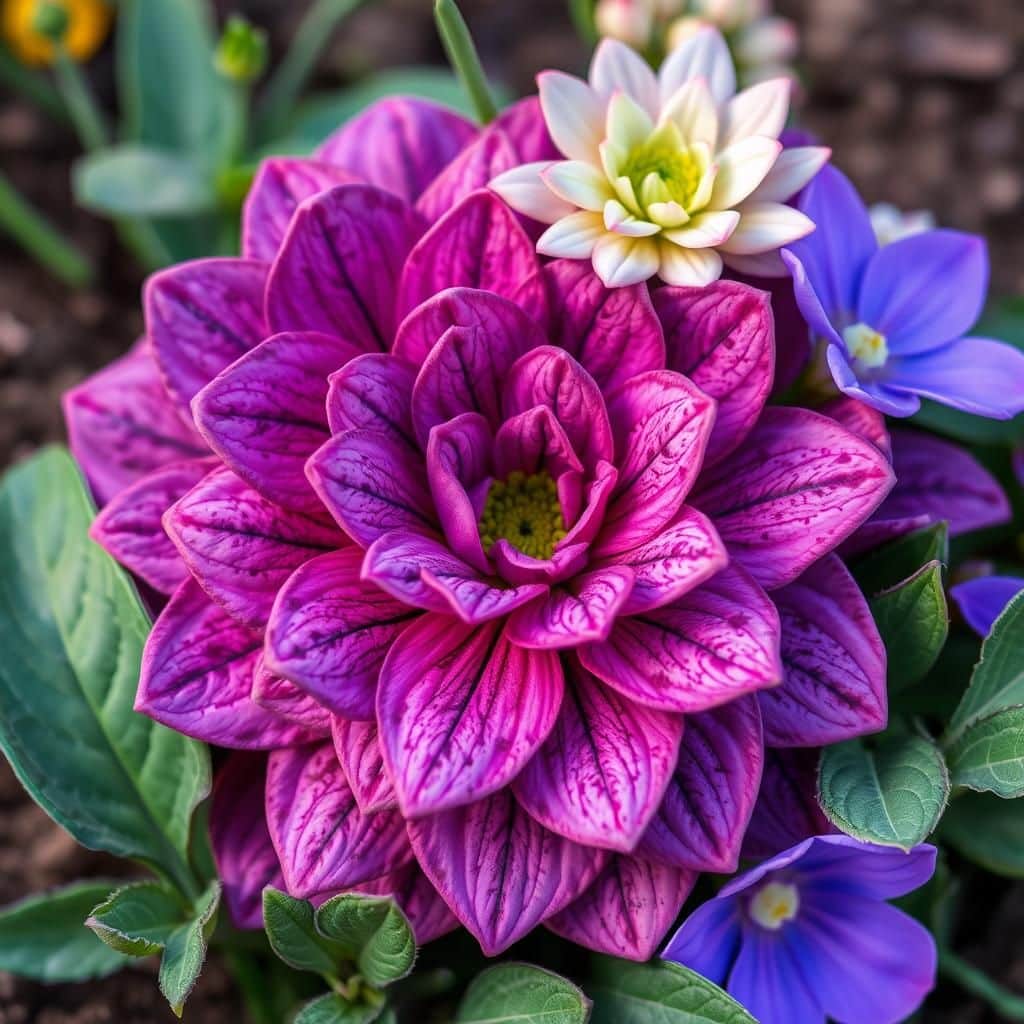Best Plants for Heavy Clay Soil: Top Choices for Thriving Gardens

Heavy clay soil can pose significant challenges for gardeners, often leading to poor drainage and restricted root growth. However, with the right plant selections, it is possible to create a thriving garden even in these difficult conditions. This article will explore the best plants suited for heavy clay soil, highlighting top choices that not only tolerate but flourish in such environments. From resilient perennials to robust shrubs, we will provide insights on how to enhance your garden's health and vitality. With the right strategies and plant choices, your clay-heavy garden can become a vibrant and productive space.
Best Plants for Heavy Clay Soil
Heavy clay soil can be quite challenging for gardeners due to its poor drainage and tendency to become compacted. However, certain plants thrive in these conditions by adapting to the high moisture levels and low aeration. Some of the best plants for heavy clay soil include native species, as they are accustomed to local conditions. These plants often have deep root systems that help break up the clay and improve the soil structure over time. Additionally, incorporating organic matter can further enhance the soil's ability to retain moisture while still allowing excess water to drain, making it a suitable environment for various perennials, shrubs, and trees that can not only survive but also flourish in heavy clay soils.
Benefits of Native Plants
Native plants are particularly advantageous in heavy clay soil as they are naturally adapted to the local climate and soil conditions. These plants typically require less maintenance and are more resilient to pests and diseases since they have evolved in their native ecosystems. By planting native species, gardeners can create sustainable landscapes that support local wildlife, including beneficial insects and pollinators, while improving the soil quality over time through their root systems that aerate and break up clay.
Perennials Suitable for Heavy Clay
Many perennials can thrive in heavy clay soil, offering a long-lasting solution for your garden. Plants such as daylilies, asters, and bee balm are excellent choices because they establish well and can tolerate fluctuating moisture levels. These hardy plants not only survive but also contribute to the biodiversity of the garden, providing beauty in the form of blooms and foliage while enhancing the overall soil structure with their roots.
Best Shrubs for Clay Soil
When it comes to shrubs, several species can thrive in heavy clay soil, offering both ornamental and functional benefits. Plants like red twig dogwood and hydrangea are well-suited for these conditions due to their ability to tolerate wet feet without succumbing to root rot. These shrubs not only provide aesthetic appeal but also serve as habitat for wildlife and can stabilize soil on slopes, preventing erosion.
Trees That Adapt Well to Clay
There are several tree species that can successfully grow in heavy clay soil, including willows, cypress, and maples. These trees are particularly suited for wet conditions, with some species able to thrive in periodically flooded areas. Planting trees that adapt to heavy clay can help improve soil drainage over time as their roots create channels through the compacted soil, enhancing the overall health of your garden landscape.
Improving Clay Soil for Better Growth
Improving heavy clay soil can be achieved by incorporating organic matter such as compost, well-rotted manure, or mulch. This amendment increases the soil's drainage, aeration, and nutrient content, making it more hospitable for both existing and new plants. Regular mixing of organic matter into the soil not only promotes healthier root systems for plants but also enhances the soil's texture and promotes the diversity of your garden ecosystem.
| Plant Type | Examples | Benefits |
|---|---|---|
| Perennials | Daylilies, Asters, Bee Balm | Long-lasting blooms, enhance biodiversity |
| Shrubs | Red Twig Dogwood, Hydrangea | Ornamental appeal, habitat for wildlife |
| Trees | Willows, Cypress, Maples | Soil drainage improvement, aesthetic value |
| Native Plants | Black-eyed Susans, Coneflowers | Low maintenance, drought-tolerant |
What plants can break up clay soil?

Clay soil can be challenging for gardening and landscaping due to its dense structure, which restricts airflow and drainage. However, certain plants can help break up clay soil over time. These plants often grow deep roots that penetrate the compacted soil, improving its texture and structure. Here are some plants known for their ability to help break up clay soil:
1. Red Clover (Trifolium pratense): This legume is known for its ability to improve soil structure. The extensive root system of red clover loosens compacted soil while also fixing nitrogen, enriching the soil for future crops.
2. Sunflowers (Helianthus annuus): Sunflowers have deep taproots that can reach more than three feet into the ground. As they grow, sunflowers can help aerate the soil and improve drainage, making clay soil more hospitable for other plants.
3. Comfrey (Symphytum officinale): Comfrey is a perennial herb with strong roots that can penetrate formidable soil layers. Besides breaking up clay, comfrey also accumulates nutrients, which can benefit surrounding plants when used as mulch.
4. Bamboo (various species): Bamboo is an aggressive grower with a vast root system. As it expands, its roots can break up clay soil, improve aeration, and help with drainage while providing a beautiful visual element to gardens.
5. Oats (Avena sativa): Planting oats in clay soil as a cover crop can help improve soil structure. The fibrous roots of oats break apart the clay, and after harvest, they add organic matter to the soil as they decompose.
See also:
Benefits of Growing Deep-Rooted Plants
Growing deep-rooted plants in clay soils offers several benefits that can lead to healthier garden ecosystems. These benefits include:
- Aeration: The roots create channels in the soil that allow air to penetrate.
- Improved Drainage: Loosened soil facilitates better water movement, preventing waterlogging.
- Increased Nutrient Availability: Decomposing roots contribute organic matter, enhancing soil fertility.
How to Amend Clay Soil With Plants
To effectively use plants for breaking up clay soil, consider amending it as follows:
- Choose Appropriate Species: Select plants known for deep rooting and clay preference.
- Plant in Succession: Rotate crops to continually improve soil structure.
- Monitor Growth: Observe how the plants affect soil texture over time.
Combining Plants with Other Soil Improvement Methods
While plants serve as an excellent method to break up clay soil, combining them with other techniques can be beneficial:
- Adding Organic Matter: Incorporate compost and mulch to enhance nutrition and soil structure.
- Mulching: Use organic mulch to retain moisture and reduce surface compaction.
- Using Cover Crops: Rotate with cover crops to prevent soil erosion and add organic material.
Potential Challenges with Clay Soil
Despite the benefits of growing plants to break up clay soil, several challenges may arise:
- Slow Decomposition: Organic matter may take longer to break down in clay soils.
- Overwatering: Roots may struggle if the soil remains too saturated.
- Pest Attraction: High clay content can attract certain pests, necessitating careful monitoring.
Timing for Planting in Clay Soil
Timing your planting in clay soil can significantly impact its effectiveness. Here are some tips for optimal planting:
- Spring Planting: Early spring is ideal for planting cover crops and deep-rooted plants.
- Fall Preparations: Consider planting before winter to allow roots to grow deeper and break up soil.
- Seasonal Monitoring: Adjust planting schedules based on weather conditions and soil moisture content.
What is the best thing for heavy clay soil?

The best thing for heavy clay soil is to improve its structure and drainage to promote healthier plant growth. Heavy clay soil is known for its tightly packed particles, which can lead to poor water drainage and aeration. To amend this type of soil, it is essential to incorporate organic matter, improve drainage, and utilize specific planting techniques to enhance the soil profile.
Amending with Organic Matter
Incorporating organic matter is one of the best strategies to improve heavy clay soil. Organic materials like compost, well-rotted manure, and leaf mold can help to break up the clay structure and improve its texture.
- Compost: Adding compost enriches the soil with nutrients and enhances water retention, promoting a balanced ecosystem.
- Well-Rotted Manure: This not only adds nutrients but also increases microbial activity, which is beneficial for plant growth.
- Leaf Mold: Made from decomposed leaves, it enhances soil structure and increases moisture-holding capacity.
Improving Drainage
To address the poor drainage common in heavy clay soil, several methods can be employed. Proper drainage techniques are vital for preventing waterlogging and ensuring the health of plant roots.
- Install Drainage Tiles: Using drainage tiles can redirect excess water away from areas where poor drainage occurs.
- Build Raised Beds: Raised beds can facilitate better drainage and soil aeration, creating a healthier environment for plants.
- Implement French Drains: These can help collect and redirect surface water, improving drainage in low-lying areas.
Utilizing Mulch
Applying mulch can significantly benefit heavy clay soil by regulating temperature and moisture levels. Mulch helps to retain moisture in the soil while preventing erosion and weed growth.
- Types of Mulch: Use organic mulches like wood chips, straw, or grass clippings to enhance soil quality over time.
- Layer Thickness: Applying a 2-4 inch layer of mulch can effectively suppress weeds and maintain soil moisture.
- Soil Temperature Regulation: Mulch acts as an insulating layer, helping to keep the soil temperature stable through different seasons.
Planting Techniques
Adopting the right planting techniques can enhance the performance of plants in heavy clay soils. Certain strategies can help mitigate the challenges posed by this type of soil.
- Choose the Right Plants: Select plants that are well-suited for heavy clay conditions, such as native grasses and hardy perennials.
- Soil Preparation: Prepare the planting hole by mixing in organic matter to create a conducive environment for roots.
- Deep Planting: Planting deeper can encourage roots to establish more effectively in heavy soil, accessing nutrients and moisture.
Regular Maintenance
Consistent maintenance is crucial for managing heavy clay soil. Regularly tending to the soil ensures long-term health and productivity of any garden.
- Soil Aeration: Aerating the soil annually helps to alleviate compaction and improve air exchange.
- Adding Gypsum: This mineral can help to break down clay particles, leading to better soil structure over time.
- Maintaining Moisture Levels: Monitoring soil moisture and watering appropriately can help prevent the soil from becoming too compacted or dry.
Can you grow in heavy clay soil?

Yes, you can grow in heavy clay soil, but it comes with its own set of challenges and considerations. Heavy clay soil is dense and has poor drainage, making it difficult for roots to penetrate and for water to flow. However, with proper management techniques, you can improve the soil quality and create a suitable environment for plants. Here are some strategies to help you grow successfully in heavy clay soil:
See also:
Understanding Heavy Clay Soil
Heavy clay soil is composed of very fine particles that are tightly packed together. This makes it more difficult for air and water to move through the soil, leading to potential issues such as poor drainage and root development.
- Composition: Heavy clay consists mainly of minerals like silica and alumina.
- Drainage: Water tends to pool rather than seep through, which can cause root rot in plants.
- Temperature: Clay soils retain heat, which can benefit some plants, but may also make it more challenging to manage moisture levels.
Improving Drainage
To make heavy clay soil more conducive to plant growth, improving drainage is essential. This can involve several methods to alter the soil’s structure.
- Amending with Organic Matter: Mixing in compost or well-rotted manure can help break up the clay particles.
- Adding Gypsum: Gypsum can help to improve soil structure without changing the soil pH.
- Creating Raised Beds: Building raised beds allows you to add lighter, more workable soil above the heavy clay, improving root access and drainage.
Selecting the Right Plants
Choosing appropriate plants that thrive in heavy clay conditions is crucial for successful gardening.
- Drought-Resistant Plants: These plants can manage excess moisture more effectively.
- Deep-Rooted Varieties: Plants with deeper root systems can penetrate clay soil better, such as certain trees and perennials.
- Native Species: Often, native plants are adapted to local soil conditions and can thrive in heavy clay.
Effective Watering Techniques
Watering in heavy clay soil requires special attention to avoid over-saturation.
- Use Drip Irrigation: This method minimizes surface runoff and delivers water directly to the root zone.
- Water Less Frequently: Allow the top few inches of soil to dry out before watering again to prevent waterlogging.
- Observe Weather Patterns: Adjust your watering schedule based on rainfall and temperature to maintain optimal moisture levels.
Regular Maintenance Practices
Regular maintenance practices will help to keep the soil healthy and productive.
- Frequent Tilling: Light tilling can improve aeration and allow organic materials to mix into the soil.
- Mulching: Applying mulch helps retain moisture, suppress weeds, and improve soil structure over time.
- Crop Rotation: Alternating crops can help maintain soil health and reduce nutrient depletion.
What is the best shrub to plant in clay soil?

To plant in clay soil, several shrubs thrive well under these challenging conditions. One of the best options is the hydrangea. Hydrangeas are particularly adaptable and can handle the moisture retention that comes with clay soils, making them an excellent choice for gardens with this type of soil.
Characteristics of Clay Soil
Clay soil is known for its compactness and density, which affects water drainage and nutrient availability. It's crucial to understand these characteristics to choose the right shrub.
- Water Retention: Clay soil tends to hold water, which can lead to root rot if drainage is poor.
- Nutrient Content: While clay soil is often rich in nutrients, its compact nature can make it difficult for plant roots to access these nutrients.
- Soil Aeration: The dense structure of clay soil can restrict air flow to roots, making it essential to select shrubs that tolerate low oxygen levels.
Best Shrubs for Clay Soil
When considering the best shrubs for clay soil, various species demonstrate compatibility with moisture-retentive conditions.
- Hydrangea macrophylla: Known for its stunning blooms, this shrub thrives in moist, clayey soils.
- Butterfly Bush (Buddleja): This drought-resistant shrub tolerates clay soil and attracts pollinators.
- Barberry (Berberis): A versatile shrub that can tolerate poor drainage and clay soils.
Benefits of Planting Hydrangeas
Hydrangeas offer several advantages when planted in clay soil, making them a popular choice among gardeners.
- Visual Appeal: Their large, vibrant flowers provide a beautiful focal point in any garden.
- Variety: Hydrangeas come in several types with different colors and sizes, allowing for diverse landscaping options.
- Hardiness: Many hydrangea species are hardy and can withstand a range of climatic conditions.
Preparation of Clay Soil
Proper preparation of clay soil can significantly enhance the growth of shrubs planted in it.
- Amendments: Adding organic matter, such as compost, can improve soil structure and drainage.
- Tilling: Turning over the soil can break up compacted layers and enhance root penetration.
- Testing pH: Assessing soil pH helps determine if amendments are needed for optimal shrub health.
Maintenance Tips for Shrubs in Clay Soil
Maintaining shrubs in clay soil requires specific practices to ensure their health and longevity.
- Watering: Providing adequate but not excessive moisture is vital, as clay soil retains water.
- Mulching: Applying mulch can help retain moisture while preventing weeds.
- Pruning: Regularly pruning shrubs encourages healthy growth and allows better air circulation.
Questions from Our Readers
What are the best plants for heavy clay soil?
Heavy clay soil can be challenging for many plants, but several species thrive in these conditions. Perennials like Daylilies and Astilbes are excellent choices, as they can tolerate the density and moisture retention of clay. Additionally, ornamental grasses such as Miscanthus work well, providing texture and stability to the soil.
How can I improve heavy clay soil for planting?
To enhance heavy clay soil, it's crucial to amend it by incorporating organic matter like compost or well-rotted manure. This practice improves drainage, increases nutrient availability, and helps break up the compactness of the soil, making it more suitable for a wider variety of plants.
See also:
Are there specific shrubs that grow well in heavy clay soil?
Yes, several shrubs are particularly well-suited for heavy clay soils, including Cotoneaster and Elderberry. These shrubs not only endure the moisture and density of clay but also provide aesthetic value and could support local wildlife with their flowers and berries.
What factors should I consider when choosing plants for heavy clay soil?
When selecting plants for heavy clay soil, consider factors such as drainage, moisture levels, and sunlight exposure. Look for plants that are specifically labeled as tolerant to wet conditions and those that have robust root systems, as they will better manage the challenges posed by heavy clay.

If you want to read more articles like Best Plants for Heavy Clay Soil: Top Choices for Thriving Gardens, we recommend you check out our Soil category.
Leave a Reply
Related Articles